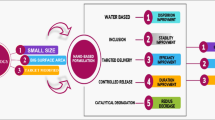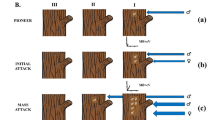Abstract
Pitchers plants of Nepenthes specie growing in infertile habitats have developed highly specialized apparatus for trapping and digesting arthropods to obtain sufficient growing nutrients. Nepenthes pitchers are generally recognized by several distinguishably morphological zones, and different districts exhibit distinct functions in prey capturing, combined effect of the several zones results in great trapping efficiency. This prey ability of Nepenthes pitchers potentially inspires an idea for biomimetic development of slippery trapping plate used in controlling agricultural pests, especially plague locust. In this paper, we reviewed the recent researches of Nepenthes pitchers, including surface structures, physical properties, and anti-attachment functions. Apart from this, combined with our latest studies on mechanical controlling plague locust, the potential application of Nepenthes pitchers as establishing biomimetic models utilized in creating trapping plate was addressed, and several corresponding aspects requiring to be paid attention to in near future were also highlighted.



Similar content being viewed by others
References
Ellison AM, Gotelli NJ (2009) Energetics and the evolution of carnivorous plants—Darwin’s ‘most wonderful plants in the world’. J Exp Bot 60:19–42
Thornham DG, Smith JM, Grafe TU et al (2012) Setting the trap: cleaning behavior of Camponotus schmitzi ants increases long-term capture efficiency of their pitcher plant host Nepenthes bicalcarata. Funct Ecol 26:11–19
Gaume L, Gorb S, Rowe N (2002) Function of epidermal surfaces in the trapping efficiency of Nepenthes alata pitchers. New Phytol 156:476–489
Benz MJ, Gorb EV, Gorb SN (2012) Diversity of the slippery zone microstructure in pitchers of nine carnivorous Nepenthes taxa. Arthropod Plant Interact 6:147–158
Riedel M, Eichner A, Jetter R (2003) Slippery surfaces of carnivorous plants: composition of epicuticular wax crystals in Nepenthes alata Blanco pitchers. Planta 218:87–97
Xu RQ, Zhou Q, Wang SM (2005) Technical development on mechanical control of locust. Trans Chin Soc Agricult Mach 36:165–168
Wang LX, Zhou Q, Xu SY et al (2009) Investigation of the sliding friction behaviors of locust on slippery plates. Chin Sci Bull 54:4549–4554
Wang LX, Zhou Q, Niu HL (2010) Influence of photoelectric stimulation with different spectrum on sliding friction behaviors of locust Oedaleus infernalis Saussure (Orthoptera: Acrididae) on slippery plates. Tribol Int 43:1163–1167
Mithofer A (2011) Carnivorous pitcher plants: insight in an old topic. Phytochemistry 72:1678–1682
Owen TP, Lennon KA (1999) Structure and development of the pitchers from the carnivorous plant Nepenthes alata (Nepenthaceae). Am J Bot 86:1382–1390
Gorb EV, Gorb SN (2006) Physicochemical properties of functional surface in pitchers of the carnivorous plant Nepenthes alata blanco (Nepenthaceae). Plant Biol 8:841–848
Bohn HF, Federle W (2004) Insect aquaplaning: Nepenthes pitcher plants capture prey with the peristome, a fully wettable water-lubricated anisotropic surface. Proc Natl Acad Sci USA 101:14138–14143
Bauer U, Bohn HF, Federle W (2008) Harmless nectar source or deadly trap: Nepenthes pitchers are activated by rain, condensation and nectar. Proc Biol Sci 275:259–265
Bauer U, Willmes C, Federle W (2009) Effect of pitcher age on trapping efficiency and natural prey capture in carnivorous Nepenthes rafflesiana plants. Ann Bot 103:1219–1226
Giusto BD, Grosbois V, Fargeas E et al (2008) Contribution of pitcher fragrance and fluid viscosity to high prey diversity in a Nepenthes carnivorous plant from Borneo. J Biosci 31:121–136
Merbach MA, Zizka G, Fiala B et al (2001) Patterns of nectar secretion in five Nepenthes species from Brunei Darussalam, Northwest Borneo and implications for ant-plant relationships. Flora 196:153–160
Bauer U, Federle W (2009) The insect-trapping rim of Nepenthes: surface structure and function. Plant Signal Behav 4:1019–1023
Bauer U, Scharmann M, Skepper J et al (2013) ‘Insect aquaplaning’ on a superhydrophilic hairy surface: how Heliamphora nutans Benth pitcher plants capture prey. Proc R Soc Lond B Biol Sci 280:20122569
Wang LX, Zhou Q (2010) Numerical characterization of surface structures of slippery zone in Nepenthes alata pitchers and its mechanism of reducing locust’s attachment force. Adv Nat Sci 3:152–160
Wang LX, Zhou Q (2011) Friction force of locust Locusta migratoria manilensis (Orthoptera, Locustidae) on slippery zones surface of pitchers from four Nepenthes species. Tribol Lett 44:345–353
Riedel M, Eichner A, Meimberg H et al (2007) Chemical composition of epicuticular wax crystals on the slippery zone in pitchers of five Nepenthes species and hybrids. Planta 225:1517–1534
Gorb E, Hass K, Henrich A et al (2005) Composite structure of the crystalline epicuticular wax layer of the slippery zone in the pitchers of the carnivorous plant Nepenthes alata and its effect on insect attachment. J Exp Biol 208:4651–4662
Scholz I, Buckins M, Dolge L et al (2010) Slippery surfaces of pitcher plants: Nepenthes wax crystals minimize insect attachment via microscopic surface roughness. J Exp Biol 213:1115–1125
Gorb E, Voigt D, Eigenbrode SD et al (2008) Attachment force of the beetle Cryptolaemus montrouzieri (Coccinellidae) on leaflet surfaces of mutants of the pea Pisum sativum (Fabaceae) with regular and reduced wax coverage. Arthropod Plant Interact 2:247–259
Gaume L, Perret P, Gorb E (2004) How do plant waxes cause flies to slide? Experimental tests of wax-based trapping mechanisms in three pitfall carnivorous plants. Arth Struct Dev 33:103–111
Gorb VE, Gorb SN (2011) The effect of surface anisotropy in the slippery zone of Nepenthes alata pitchers on beetle attachment. Beilstein J Nanotechnol 2:302–310
Dai ZD, Gorb SN, Schwarz U (2002) Roughness-dependent friction force of the tarsal claw system in the beetle Pachnoda marginata (Coleoptera, Scarabaeidae). J Exp Biol 205:2479–2488
Goodwyn PP, Souza ED, Fujisaki K et al (2008) Moulding technique demonstrates the contribution of surface geometry to the super-hydrophobic properties of the surface of a water strider. Acta Biomater 4:766–770
Perez GP, Peressadko A, Schwarz H et al (2006) Material structure, stiffness, and adhesion: why attachment pads of the grasshopper (Tettigonia viridissima) adhere more strongly than those of the locust (Locusta migratoria) (Insecta: Orthoptera). J Comp Physiol A 192:1233–1243
Scholz I, Baumgartner W, Federle W (2008) Micromechanics of smooth adhesive organs in stick insects: pads are mechanically anisotropic and softer towards the adhesive surface. J Comp Physiol A 194:373–384
Brennan EB, Weinbaum SA (2001) Effect of epicuticular wax on adhesion of psyllids to glaucous juvenile and glossy adult leaves of Eucalyptus globulus Labillardiere. Austral J Entomol 40:270–277
Gorb EV, Gorb SN (2002) Attachment ability of the beetle Chrysolina fastuosa on various plant surfaces. Entomol Exp Appl 105:13–28
Gorb EV, Gorb SN (2008) Contact mechanics at the insect–plant interface: how do insects stick and how do plants prevent this? In: IUTAM bookseries. Springer Netherlands, pp 243–252
Huber G, Gorb SN, Hosoda N et al (2007) Influence of surface roughness on gecko adhesion. Acta Biomater 3:607–610
Persson BNJ, Gorb SN (2003) The effect of surface roughness on the adhesion of elastic plates with application to biological systems. J Chem Phys 119:11437–11444
Wolff JO, Gorb SN (2012) Surface roughness effects on attachment ability of the spider Philodromus dispar (Araneae, Philodromidae). J Exp Biol 215:179–184
Waltraud S, Wolf BF, John MW (1999) Transporters for ammonium, amino acids and peptides are expressed in pitchers of the carnivorous plant Nepenthes. Plant J 17:637–646
Ishisaki K, Arai S, Hamada T et al (2012) Biochemical characterization of a recombinant plant class III chitinase from the pitcher of the carnivorous plant Nepenthes alata. Carbohydr Res 361:170–174
Hatano N, Hamada T (2012) Proteomic analysis of secreted protein induced by a component of prey in pitcher fluid of the carnivorous plant Nepenthes alata. J Proteomics 75:4844–4852
Gorb E, Kastner V, Peressadko A et al (2004) Structure and properties of the glandular surface in the digestive zone of the pitcher in the carnivorous plant Nepenthes ventrata and its role in insect trapping and retention. J Exp Biol 207:2947–2963
Mizunami M (1995) Functional diversity of neural organization in insect ocellar systems. Vision Res 4:443–452
Lazzari CR, Reiseman CE, Insausti TC (1998) The role of the ocelli in the phototactic behavior of the haematophagous bug Triatoma infestans. J Insect Physiol 44:1159–1162
Erber J, Hoormann J, Scheiner R (2006) Phototactic behavior correlates with gustatory responsiveness in honey bees (Apis mellifera L.). Behav Brain Res 174:174–180
Fowler MA, Montell C (2013) Drosophila TRP channels and animal behavior. Life Sci 92:394–403
Barry CK, Jander R (1968) Photoinhibitory function of the dorsal ocelli in the phototactic reaction of the migratory locust Locusta migratoria L. Nature 217:675–677
Farrow RA (1974) A modified light-trap for obtaining large samples of night-flying locusts and grasshoppers. J Aust Ent Soc 13:357–360
Kinoshita M, Pfeiffer K, Homberg U (2007) Spectral properties of identified polarized-light sensitive interneurons in the brain of the desert locust Schistocerca gregaria. J Exp Biol 210:1350–1361
Liu QH, Zhou Q (2011) Influence of trapping light source illuminance gradient on locusts’ phototactic effect. Trans Chin Soc Agricult Mach 42:105–109
Liu QH, Zhou Q, Niu HL (2011) Comparison and mathematical analysis of locust phototactic response to spectral illumination. Trans Chin Soc Agric Eng 27:252–256
Liu QH, Zhou Q (2011) Experiment of locust phototactic response to flash and cosine alternating light. J Jiangsu Univ (Natural Science Edit) 32:148–152
Niu HL, Wang LX, Zhou Q (2013) Influence of light and mechanical stimuli on behavior of locust. Trans Chin Soc Agric Eng 29:152–256
Tuteja A, Choi W, Ma ML et al (2007) Designing superoleophobic surfaces. Science 318:1618–1622
Koch K, Bhushan B, Barthlott W (2009) Multifunctional surface structures of plants: an inspiration for biomimetics. Prog Mater Sci 54:137–178
Wang JD, Chen HS, Sui T et al (2009) Investigation on hydrophobicity of lotus leaf: experiment and theory. Plant Sci 176:687–695
Wang LX, Zhou Q, Liu QH (2011) Dimensions of surface structures of slippery zone in Nepenthes pitchers and bionic design of locust trapping plate. Trans Chin Soc Agricult Mach 42:233–235
Wang LX, Zhou Q (2011) Function testing of locust slippery plate manufactured based on waxy zone of Nepenthes pitchers. Trans Chin Soc Agricult Mach 42:222–225
Acknowledgments
This work was supported by the National Natural Science Foundation of China (51205107), the Natural Science Foundation of Hebei Province (E2014208056), the Tribology Science Fund of State Key Laboratory of Tribology (SKLTKF13B05) and the Scientific Research Fund for Doctors of Hebei University of Science and Technology (QD201238). Sincere thanks to the anonymous reviewers for their significantly valuable suggestions and viewpoints to this manuscript.
Author information
Authors and Affiliations
Corresponding author
About this article
Cite this article
Wang, L., Zhou, Q. Nepenthes pitchers: surface structure, physical property, anti-attachment function and potential application in mechanical controlling plague locust. Chin. Sci. Bull. 59, 2513–2523 (2014). https://doi.org/10.1007/s11434-014-0383-6
Received:
Accepted:
Published:
Issue Date:
DOI: https://doi.org/10.1007/s11434-014-0383-6




